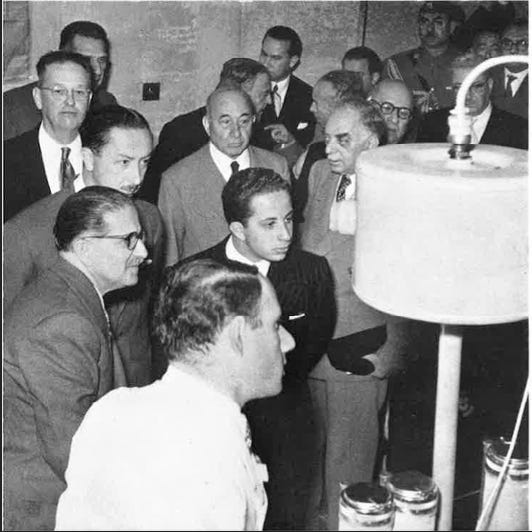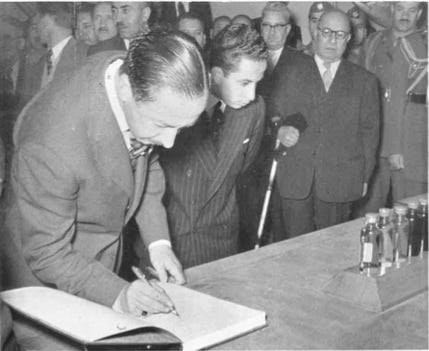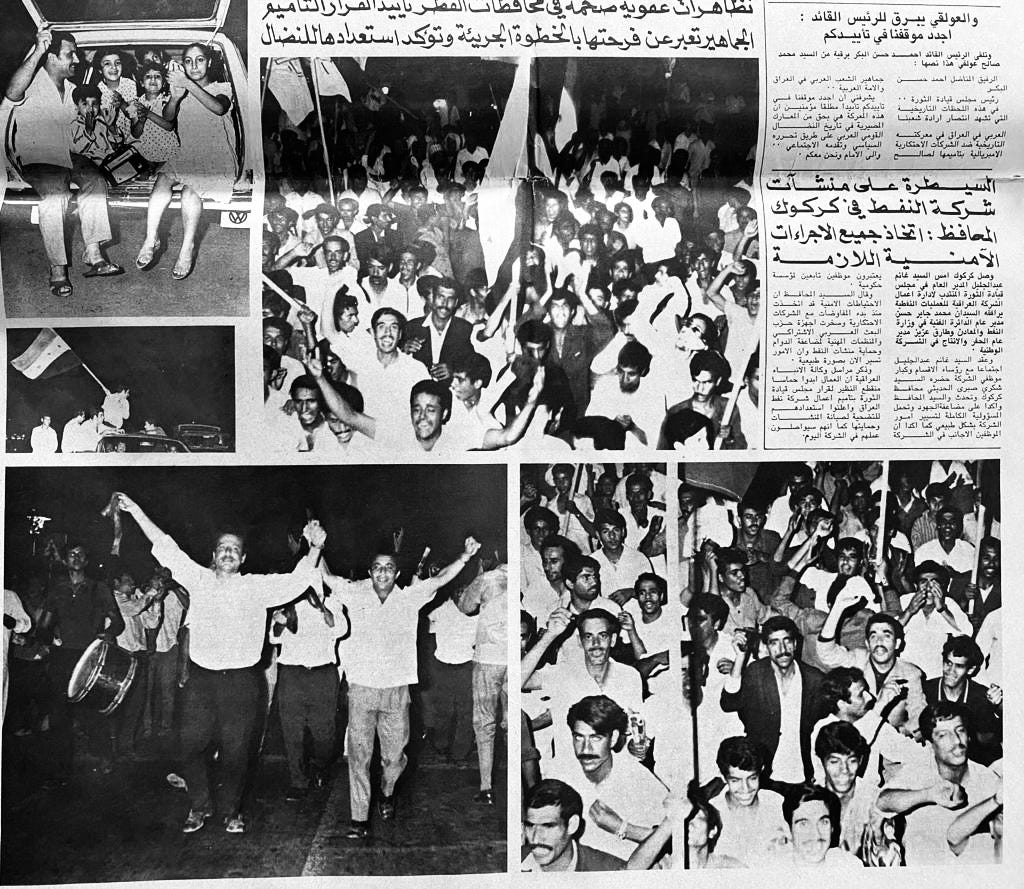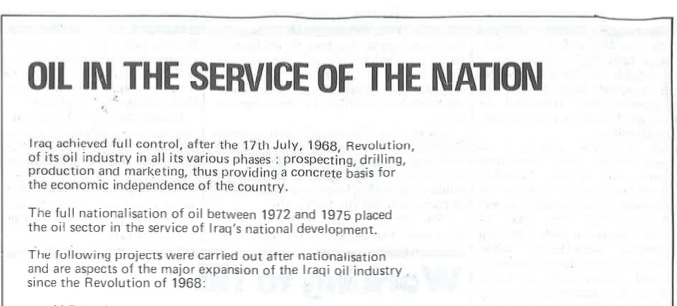
Hello there, Noam here. Today I am sharing the first of a two-part series on Daura, the aging oil refinery in Iraq. As always, feel free to share comments and thoughts — or even a memory.
King Faisal I dreamed of building an oil refinery in Iraq. It took more than two decades, but it eventually came true during the reign of his grandson, Faisal II. On November 28, 1954, the refinery at Daura, in southern Baghdad, was inaugurated. It “was an occasion of great historical significance” according to Iraq Petroleum magazine. Daura continues to operate to this day, rumbling along the mighty, yet ailing, Dijlah river. It has survived revolution and war, bearing witness to critical moments in Iraqi history.
Daura was run by Western technicians since its opening, but they eventually left following the overthrow of the British-installed monarchy in the summer of 1958. Their positions were filled by a new class of trained and educated Iraqis. Daura was there in 1991, too. Following the catastrophic Iraqi invasion of Kuwait, American bombers hammered and seriously damaged the refinery. Undeterred by the destruction, veteran Iraqi workers labored day and night to repair it. To the surprise of many, production was soon restored. In 2003, the refinery became a fortress. Its workers, led by former director general Dathar al-Khashab, struggled to protect it against looters in the early, chaotic days of the US invasion.
Today, grey smoke billows out from its stacks. Together with a neighboring power plant, Daura pollutes the air of densely populated parts of Baghdad, which feels like a city that constantly struggles to breathe.
My interest in the history of Daura developed while searching for and collecting old magazines and newspapers. When I stumbled upon a 1955 copy of what was once known as Iraq Petroleum magazine, I was pulled into times that now seem lost to history. The leading story was about the inauguration of the refinery. I gladly lingered in the past for weeks.
I share below what I have gathered about the history of Daura. I would not have been able to reconstruct some of the events below without the help of people who kindly shared their knowledge and memories with THE CHOKEPOINT. It is difficult not to be taken by their feelings of nostalgia for the days when Daura was seen as the backbone of a modernizing Iraq.

A Major Industrial Development Project
Some readers may be familiar with the historic picture above taken by the Iraq Petroleum Company (IPC) Photographic Unit in Baghdad, which I found in an article in Iraq Petroleum from February 1955. It shows King Faisal II touring Daura alongside some officials, including Prime Minister Nuri al-Said and Economy Minister Nadim al-Pachachi, the future secretary-general of OPEC. Describing the refinery as “the largest Government-operated enterprise in the Middle East,” al-Pachachi noted in a speech that King Faisal I “was one of the first to advocate the building of a Government Oil Refinery a quarter a century ago,” though it was impossible at the time due to technical and financial challenges.
The inauguration of Daura was significant given that Iraq had no refining capacity and was dependent on imported petroleum products. According to Saadallah al-Fathi, who was president of the State Organization of Oil Refining and Gas Industry from 1980 to 1986, Iraq used to import petroleum products from the Abadan refinery in Iran, “which was the largest refinery at that time in the region.” He adds that Iraq also relied on petroleum products from a small refinery (with a capacity of 10,000 bpd, or barrels per day) near the border with Iran, which was built in 1924, in addition to “smaller refining units that belonged to oil companies.”
The construction of Daura began in June 1953. It was carried out by around 4,000 Iraqis and several American and British technicians. The M.W. Kellogg Company (now part of KBR) designed, supplied, and set up the necessary machinery and equipment, while D.C. and William Press Ltd conducted the civil engineering work. In addition to these companies, a firm that belonged to Sir Alexander Gibb offered consultancy services.

Daura was designed to process 24,000 bpd of Kirkuk crude oil. This refining capacity would later be increased through necessary adjustments and new equipment. The crew that oversaw the operation of the refinery was comprised of 40 Iraqi, 50 American, and 14 British engineers in addition to “900 skilled, semi-skilled and unskilled workers.”
The Kirkuk crude oil was pumped to Daura through a pipeline from a pumping station at K-2 (Baiji) in northern Iraq. Construction on this pipeline began in December 1953 and was finalized the following year. The work was conducted “by the Iraq Petroleum Company on behalf of the Iraq Government” and was led by 450 Iraqi workers and 15 foreign experts.
Back then, the Iraq Petroleum Company (IPC) had full control over Iraq’s national oil production. It was a consortium comprising companies like BP, Exxon, Mobil, CFP, Shell, and Partex. The IPC was eventually nationalized in 1972 as part of Iraqi maneuvers against foreign monopolies.

The Winds of Change
In the decades that followed the overthrow of the monarchy, Iraqi engineers, technicians, chemists, and physicists oversaw Daura’s operations. The refinery, according to Saadallah al-Fathi, turned into a source of expertise and “was always in the lead, ready to assist other industries in various services, including maintenance work, and engineering inspection.” Daura’s technicians even assisted in kick-starting operations at other refineries in the country, such as Basra in 1972 and Baiji in 1982, according to al-Fathi. By the end of the 1970s, when the Baath party was in power, Iraq was boasting about the various oil industry projects it had implemented, including Daura.

Daura underwent upgrades in the years that followed. These included crude distillation units, in which crude oil is heated until different product fractions boil into a gas before condensing individually, and a Kerosene Hydrotreating Unit that was constructed in 1969 with the assistance of Technoexport, a Czechoslovakian company. The hydrotreating process involves removing unwanted elements, such as sulfur. A reforming complex, to increase gasoline octane, was also built in 1959 and 1978 and consisted of a hydrotreater unit, Reformer Unit, and Liquefied Petroleum Gases, according to official data from 2014, and Saadallah al-Fathi.
However, by the 1980s, Iraq’s senior oil engineers were realizing that Daura had to be phased out gradually due to its location close to central Baghdad, where the population was growing. Al-Fathi recalls that in 1983, when he was the president of the State Organization of Oil Refining and Gas Industry, he requested a group of senior technicians to provide a study on the future of Daura:
“The group agreed in its report that we should not carry out any expansions at the refinery, and instead seek to halt the refinery gradually especially after the completion of the Baiji refineries and what used to be called al-Wasat refinery at that time … and which was planned to replace the Daura refinery.”
But this plan did not materialize, at least in part because of the drawn-out war with Iran.
Iran’s F-4s After Daura
During the war, Daura was a target of Iranian forces. To understand what happened during that period and its aftermath, I reached out to the former director general of Daura, Dathar Yehya al-Khashab. Al-Khashab is 78 years old and began working as an electrical engineer at Daura in 1968. In his hoarse voice, he brought me back to the early 1980s, when an Iranian F-4 tried and failed to hit the refinery:
“Balloons were released around Daura so that any enemy warplanes that wanted to hit the refinery had to fly high above the balloons. As a result, Iranian forces moved away from Daura due to the protection it had and focused on targeting other location.”
Various sources appear to corroborate al-Khashab’s account. In The Role of Airpower in the Iran-Iraq War, for example, Major Ronald E. Bergquist mentions that F-4s “trying to hit an oil refinery south of Baghdad missed the refinery by three-quarters of a mile.” This is a clear reference to Daura, which along with a refinery in Basra was the major refinery in the country in 1980. Unlike Daura, however, Iranian forces were able to hit the refinery in Basra. “The Basra refinery during the war was a target and it stopped operating. Only Daura remained in operation, supplying not only oil products like gasoline and diesel, but also jet fuel for warplanes,” al-Khashab told me.
Then came the Gulf War in 1991. Daura was burning.
“Night Turned into Day”
…To be continued on Thursday, Aug 18.




I discovered this posting by serendipity, and I cannot thank you enough for the information. My family lived in Baghdad in 1954 - 55. I was only 4 at the time, but I have vivid memories of the country and of the immense kindness of Iraqis. I have been searching for the refinery which my father helped construct. Although an American, he worked for the M.W. Kellogg Co. out of the London office. What a delight to see M.W. Kellogg cited. Thank you so much!
Excellent article on the Daura Refinery. Well done.